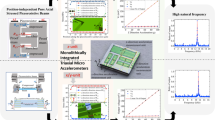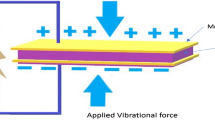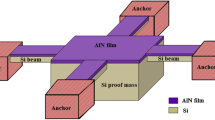Abstract
This study applies energy method to derive the system modeling of a triaxial microaccelerometer that consists of a quadri-beam suspension, a seismic mass, and displacement transducers using piezoelectric thin films. Two suspension beams support both ends of the seismic mass, which is fabricated by anisotropic etching of silicon. An out-of-plane acceleration will result in a symmetric bend, and in-plane accelerations will produce asymmetric bend and torsion of the suspension beams. Two piezoelectric thin-film transducers are arranged at both ends of each suspension beam. Eight transducers in total are interconnected such that triaxial accelerations can be measured selectively. The structure stiffness of the suspension beams considers both the silicon beams and piezoelectric films by the use of the laminated beam theory. Therefore, the analytical model is applicable to the accelerometers with thick piezoelectric films. The model is based on the anisotropic material properties of Silicon and PZT and Euler’s beam equation with the assumptions that smaller strains and stresses are negligible. The analytical results of the resonant frequencies and sensor sensitivities to triaxial accelerations are presented and confirmed by finite element analysis.













Similar content being viewed by others
References
Chae J, Kulah H, Najafi K (2005) A monolithic three-axis micro-g micromachined silicon capacitive accelerometer. J Microelectromech Syst 14(2):235–241
DeVoe DL, Pisano AP (2001) Surface micromachined piezoelectric accelerometers. J Microelectromech Syst 10(2):180–186
Gere JM, Timoshenko SP (1997) Mechanics of materials, 4th edn. PWS Publishing Company, Boston, MA
Hellwege K-H, Hellwege AM (eds) (1981) Ferroelectrics and related substances. Springer, Berlin, Heidelberg, New York
Hindrichsen CC, Almind NS, Brodersen SH, Hansen O, Thomsen EV (2009) Analytial model of a PZT thick-film triaxial acceleromter for optimum design. IEEE Sensor J 9(4):419–429
Kunz K, Enoksson P, Stemme G (2001) Highly sensitive triaxial silicon accelerometer with integrated PZT thin film detectors. Sens Actuators A 92(1):156–160
Lemkin MA, Boser BE, Auslander D, Smith JH (1997) A 3-axis balanced accelerometer using a single proof-mass. In: Proceedings of transducer, Chicago, IL, June 16–19, pp 1185–1188
Lowrie C, Desmulliez MPY, Hoff L, Elle OJ, Fosse E (2009) MEMS three-axis accelerometer: design, fabrication and application of measuring heart wall motion. In: Proceedings of design, test, integration & packaging of MEMS/MOEMS, pp 229–234
Takao H, Fukumoto H, Ishida M (2001) A CMOS integrated three-axis accelerometer fabricated with commercial submicrometer CMOS technology and bulk-micromachining. IEEE Trans Electron Dev 48(9):1961–1968
Thomson WT, Dahleh MD (1998) Theory of vibration with application, 5th edn. Prentice-Hall, New Jersey
Timoshenko SP, Goodier JN (1970) Theory of elasticity, 3rd edn. McGraw-Hill, New York
van Kampen RP, Wolffenbuttel RF (1998) Modeling the mechanical behavior of bulk-micromachined silicon accelerometers. Sens Actuators A 64:137–150
Wang L-P, Wolf RA Jr, Wang Y, Deng KK, Zou L, Davis RJ, Trolier-McKinstry S (2003) Design fabrication and measurement of high-sensitivity piezoelectric microelectromechanical systems accelerometers. J Microelectromech Syst 12(4):433–439
Wang Q-M, Yang Z, Li F, Smolinski P (2004) Analysis of thin film piezoelectric microaccelerometer using analytical and finite element modeling. Sens Actuators A 113(1):1–11
Wortman JJ, Evans RA (1965) Young’s modulus, shear modulus, and Poisson’s ratio in silicon and germanium. J Appl Phys 36(1):153–156
Yu J-C, Lan C-B (2001) System modeling of microaccelerometer using piezoelectric thin films. Sens Actuators A 88(2):178–186
Zhu M, Kirby P, Lim MY (2004) Lagrange’s formalism for modeling of a triaxial microaccelerometer with piezoelectric thin-film sensing. IEEE Sens J 4(4):455–463
Zou Q, Tan W, Kim ES, Loeb GE (2008) Single- and triaxis piezoelectric-bimorph accelerometers. J Microelectromech Syst 17(1):45–57
Acknowledgments
The authors would like to thank the National Science Council of the Republic of China, Taiwan, for financially supporting this research under Contract No. NSC 97-2221-E-327 -011 -MY2.
Author information
Authors and Affiliations
Corresponding author
Rights and permissions
About this article
Cite this article
Yu, JC., Lee, C., Kuo, W. et al. Modeling analysis of a triaxial microaccelerometer with piezoelectric thin-film sensing using energy method. Microsyst Technol 17, 483–493 (2011). https://doi.org/10.1007/s00542-011-1258-2
Received:
Accepted:
Published:
Issue Date:
DOI: https://doi.org/10.1007/s00542-011-1258-2




